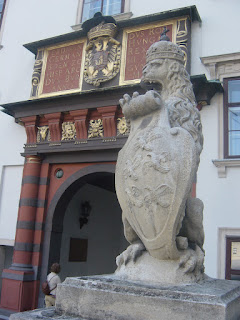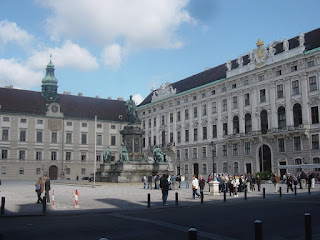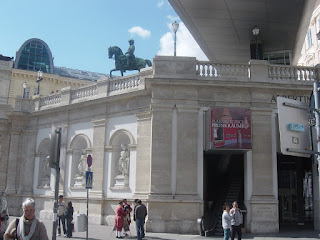Above right: mixed meat platter at Restaurant D'Landsknecht
Above: potatoes (left); semolina dumpling soup (right) at Restaurant D'Landsknecht
Above left: Viennese beef stew at Restaurant D'Landsknecht
Above right: The Austrian Parliament Building with the statue of Athena (the goddess of wisdom) in front
Above left: The Secession Building served as the exhibition hall for the Vienna Secession, a movement of modernist artists, including Gustav Klimt, Egon Schiele, and Oskar Kokoschka, who broke from academic traditions to explore new creative possibilities ~ chaos isn't evil per se, but it can be a catalyst to bring down old structures to make room for something entirely new and innovative.
Above: Naschmarkt, Wien (Vienna)’s most famous open-air market
Above: Wien (Vienna)'s Walk of Fame (near the Naschmarkt)
Above: Vienna State Opera (Wiener Staatsoper), opened in 1869 and rebuilt after World War II
Above: St. Stephen's Cathedral (Stephansdom), founded in 1137
Above right: Peterskirche (St. Peter's Church), founded in 1701
Above: The stunning Baroque interior of Peterskirche (St. Peter's Church)
Above: The Holocaust Memorial in Judenplatz, also called the Nameless Library ~ its concrete structure resembles a sealed library with books turned inward, symbolizing stories that were never told.
Above right: A charming artisanal watchmaker and clock repair shop
Above: Pestsäule, also known as the Plague Column, is a striking Baroque monument erected in 1679 to commemorate the end of the Great Plague that devastated the city.
Above: Kohlmarkt, a prestigious shopping street with high-end boutiques, jewelers, and historic cafes ~ the Hofburg Palace is recognizable by its green dome in the background.
Above left: Two salmon wraps - €5.90; Above right: The Hofburg Palace ~ it has served as the winter residence of the Habsburg dynasty and now houses museums and the Austrian National Library.
Above: This archaeological site in front of the Hofburg Palace reveals Wien (Vienna)'s layered architectural history, with remnants potentially dating back to Roman or medieval periods.
Above right: The entrance to the Hofburg Palace, flanked by two dramatic Hercules statues - one depicting Hercules battling a serpent, while the other shows him rescuing Hesione, a princess from Greek mythology.
Above: In der Burg, the central courtyard of the Hofburg Palace ~ the square is home to the monument of Emperor Francis II/I, surrounded by statues representing virtues like wisdom and strength.
Above: Swiss Gate (Schweizertor) in the Hofburg Palace complex ~ the inscriptions reference Emperor Ferdinand I and mark the gate's completion in 1552.
Above right: The Neue Burg, a wing of the Hofburg Palace complex ~ in front of the building is the equestrian monument of Prince Eugene of Savoy. Prince Eugene was one of Austria’s most celebrated military commanders, known for his victories against the Ottoman Empire.
Above left: The statue facing Prince Eugene of Savoy is the equestrian statue of Archduke Charles, a celebrated Austrian military leader known for his victories against Napoleon.
Above: Burgkapelle (Royal Chapel) in the Hofburg Palace ~ €4.50 entrance fee for three. Originally built between 1447 and 1449, its interior was later enhanced with baroque modifications in the 17th and 18th centuries.
Above: This chapel is known for hosting the famous Vienna Boys' Choir during Sunday Masses.
Above: The Michaelerkuppel, the grand copper-covered dome of the Hofburg Palace, crowns the Michaelertrakt, a wing of the palace complex that serves as a striking entrance from Michaelerplatz.
Above right: This humongous bratwurst cost €2.90.
Above left: Monument Against War and Fascism
Above right: The Albertina, an art museum housed in a former Habsburg residential palace, with Archduke Albrecht Monument in the foreground
Above left: Another view of the Vienna State Opera (Wiener Staatsoper)
Above right: One of the Habsburg staterooms in the Albertina, a former royal residence. Admission for three people to the Albertina was €25.50.
Above left: Sacher Torte, apple strudel, and three espressos at Sacher Hotel Coffee House ~ €20 for a taste of tradition, indulgence, and history




Above: A delicious Chinese dinner, courtesy of Mom (€29)















































































































































No comments:
Post a Comment